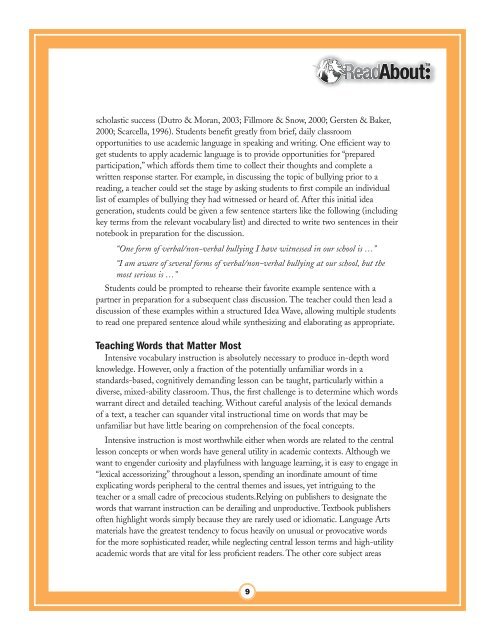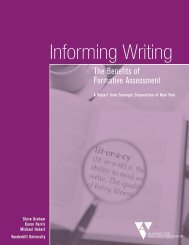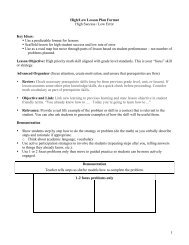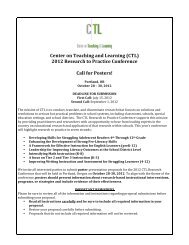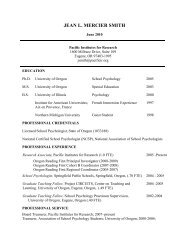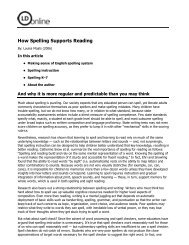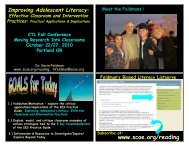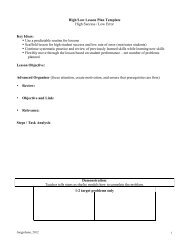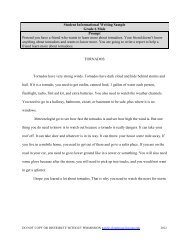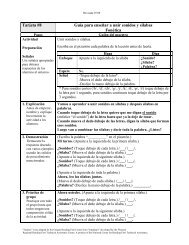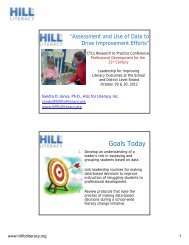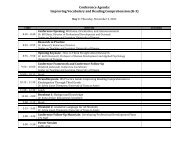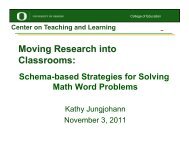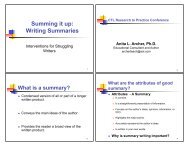Narrowing the Language Gap: - Center on Teaching and Learning ...
Narrowing the Language Gap: - Center on Teaching and Learning ...
Narrowing the Language Gap: - Center on Teaching and Learning ...
- No tags were found...
Create successful ePaper yourself
Turn your PDF publications into a flip-book with our unique Google optimized e-Paper software.
TMscholastic success (Dutro & Moran, 2003; Fillmore & Snow, 2000; Gersten & Baker,2000; Scarcella, 1996). Students benefit greatly from brief, daily classroomopportunities to use academic language in speaking <strong>and</strong> writing. One efficient way toget students to apply academic language is to provide opportunities for “preparedparticipati<strong>on</strong>,” which affords <str<strong>on</strong>g>the</str<strong>on</strong>g>m time to collect <str<strong>on</strong>g>the</str<strong>on</strong>g>ir thoughts <strong>and</strong> complete awritten resp<strong>on</strong>se starter. For example, in discussing <str<strong>on</strong>g>the</str<strong>on</strong>g> topic of bullying prior to areading, a teacher could set <str<strong>on</strong>g>the</str<strong>on</strong>g> stage by asking students to first compile an individuallist of examples of bullying <str<strong>on</strong>g>the</str<strong>on</strong>g>y had witnessed or heard of. After this initial ideagenerati<strong>on</strong>, students could be given a few sentence starters like <str<strong>on</strong>g>the</str<strong>on</strong>g> following (includingkey terms from <str<strong>on</strong>g>the</str<strong>on</strong>g> relevant vocabulary list) <strong>and</strong> directed to write two sentences in <str<strong>on</strong>g>the</str<strong>on</strong>g>irnotebook in preparati<strong>on</strong> for <str<strong>on</strong>g>the</str<strong>on</strong>g> discussi<strong>on</strong>.“One form of verbal/n<strong>on</strong>-verbal bullying I have witnessed in our school is …”“I am aware of several forms of verbal/n<strong>on</strong>-verbal bullying at our school, but <str<strong>on</strong>g>the</str<strong>on</strong>g>most serious is …”Students could be prompted to rehearse <str<strong>on</strong>g>the</str<strong>on</strong>g>ir favorite example sentence with apartner in preparati<strong>on</strong> for a subsequent class discussi<strong>on</strong>. The teacher could <str<strong>on</strong>g>the</str<strong>on</strong>g>n lead adiscussi<strong>on</strong> of <str<strong>on</strong>g>the</str<strong>on</strong>g>se examples within a structured Idea Wave, allowing multiple studentsto read <strong>on</strong>e prepared sentence aloud while syn<str<strong>on</strong>g>the</str<strong>on</strong>g>sizing <strong>and</strong> elaborating as appropriate.<strong>Teaching</strong> Words that Matter MostIntensive vocabulary instructi<strong>on</strong> is absolutely necessary to produce in-depth wordknowledge. However, <strong>on</strong>ly a fracti<strong>on</strong> of <str<strong>on</strong>g>the</str<strong>on</strong>g> potentially unfamiliar words in ast<strong>and</strong>ards-based, cognitively dem<strong>and</strong>ing less<strong>on</strong> can be taught, particularly within adiverse, mixed-ability classroom. Thus, <str<strong>on</strong>g>the</str<strong>on</strong>g> first challenge is to determine which wordswarrant direct <strong>and</strong> detailed teaching. Without careful analysis of <str<strong>on</strong>g>the</str<strong>on</strong>g> lexical dem<strong>and</strong>sof a text, a teacher can squ<strong>and</strong>er vital instructi<strong>on</strong>al time <strong>on</strong> words that may beunfamiliar but have little bearing <strong>on</strong> comprehensi<strong>on</strong> of <str<strong>on</strong>g>the</str<strong>on</strong>g> focal c<strong>on</strong>cepts.Intensive instructi<strong>on</strong> is most worthwhile ei<str<strong>on</strong>g>the</str<strong>on</strong>g>r when words are related to <str<strong>on</strong>g>the</str<strong>on</strong>g> centralless<strong>on</strong> c<strong>on</strong>cepts or when words have general utility in academic c<strong>on</strong>texts. Although wewant to engender curiosity <strong>and</strong> playfulness with language learning, it is easy to engage in“lexical accessorizing” throughout a less<strong>on</strong>, spending an inordinate amount of timeexplicating words peripheral to <str<strong>on</strong>g>the</str<strong>on</strong>g> central <str<strong>on</strong>g>the</str<strong>on</strong>g>mes <strong>and</strong> issues, yet intriguing to <str<strong>on</strong>g>the</str<strong>on</strong>g>teacher or a small cadre of precocious students.Relying <strong>on</strong> publishers to designate <str<strong>on</strong>g>the</str<strong>on</strong>g>words that warrant instructi<strong>on</strong> can be derailing <strong>and</strong> unproductive. Textbook publishersoften highlight words simply because <str<strong>on</strong>g>the</str<strong>on</strong>g>y are rarely used or idiomatic. <str<strong>on</strong>g>Language</str<strong>on</strong>g> Artsmaterials have <str<strong>on</strong>g>the</str<strong>on</strong>g> greatest tendency to focus heavily <strong>on</strong> unusual or provocative wordsfor <str<strong>on</strong>g>the</str<strong>on</strong>g> more sophisticated reader, while neglecting central less<strong>on</strong> terms <strong>and</strong> high-utilityacademic words that are vital for less proficient readers. The o<str<strong>on</strong>g>the</str<strong>on</strong>g>r core subject areas9


